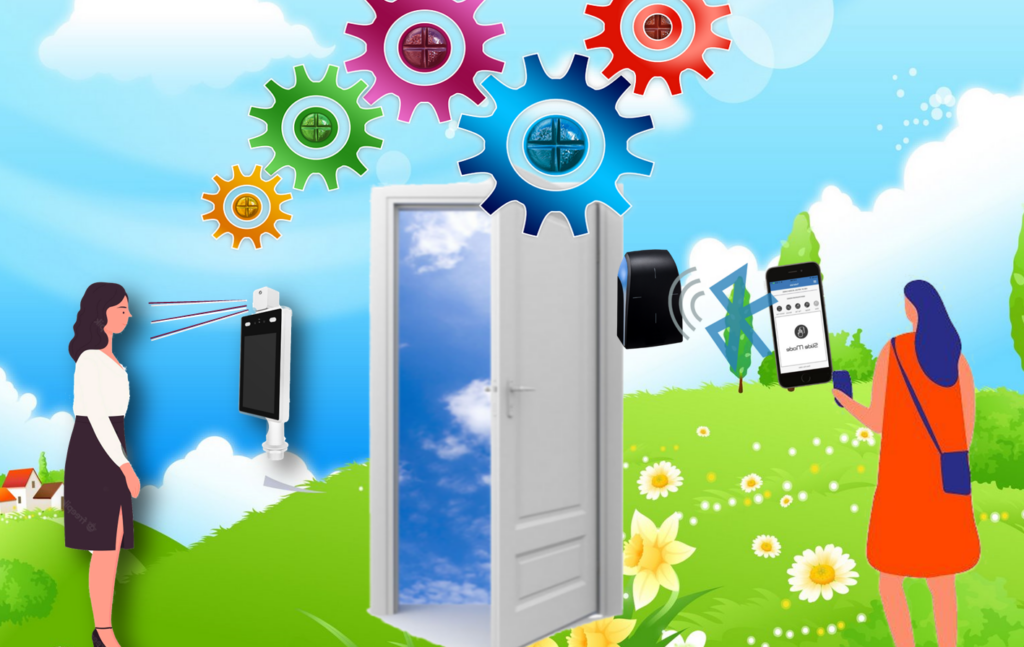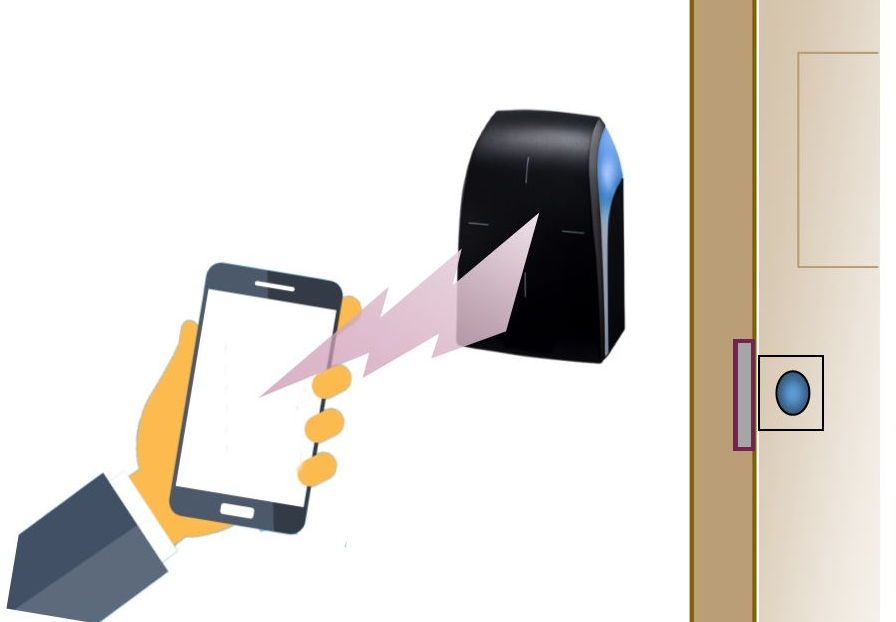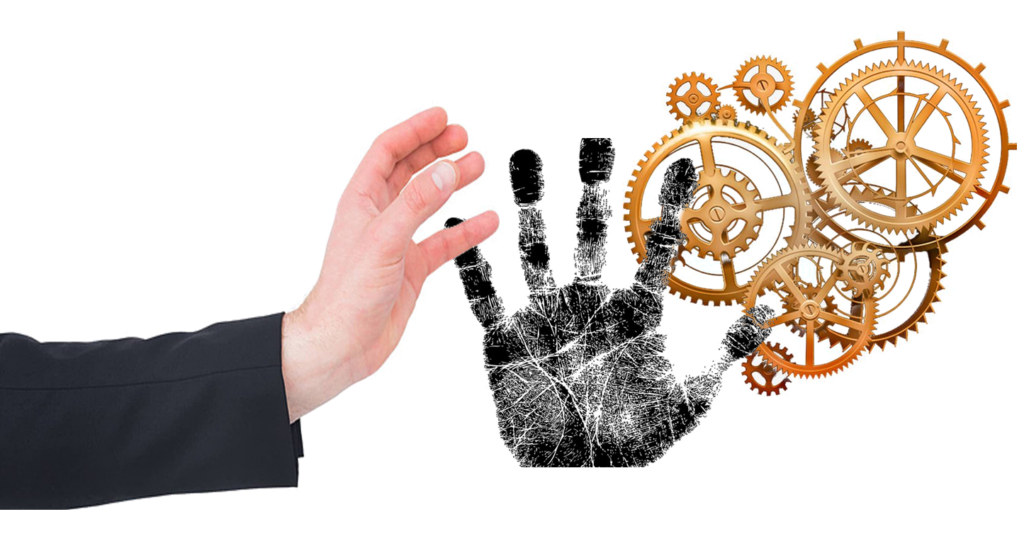The Pros and Cons of Mobile and Biometric Door Readers

Over the past few years, significant advancements have been made in access control system security. The first door readers used a keypad that allowed the user to enter their ID number. Later, door readers used proximity cards that provided better security, but cards could be lost or given to others. The latest door readers offer much better protection and are easier to use. They read mobile credentials embedded in a person’s smartphone or biometric readers that identify a person’s identifying characteristics. Card credentials are not required.
This article compares the newest door readers used in Access Control Systems.
Mobile Smartphone Credentials for Access Control

Now, your smartphone is your access key. You don’t need to carry a card credential. A smartphone App connects your smartphone to its readers using Bluetooth. This mobile credential is one of the latest ways of controlling your door access. There are several mobile credential readers available.
Benefits of Mobile Credentials:
- Cost Savings: The mobile credential reduces the need for physical card production, distribution, and replacement, which can result in significant cost savings over time.
- Improved security: People can give their card credentials to someone else but are unlikely to give away their smartphones.
- Reduced Waste: By eliminating the need for physical cards or keys, mobile credentials contribute to less plastic waste and a smaller environmental footprint.
- Very easy to use: Mobile credentials eliminate the need to carry physical keys, cards, or badges. Users can access secured areas using their smartphones, which they are likely to always have with them. It’s more convenient than an ID card.
- Remote Management: Credentials can be issued, updated, or revoked remotely, reducing the need for physical interaction and manual processes.
- You can select an entry mode that doesn’t require taking out your smartphone. Just wave your hand in front of the reader to open the door.
Disadvantages of Mobile Credentials
- Requires a smartphone: It is not practical for a population that doesn’t have a smartphone.
- Higher cost: These readers cost more than the older proximity readers.
- Dependence on Network Connectivity: There areInternet or Bluetooth Requirements: Some mobile credential systems require an Internet connection or Bluetooth to function correctly. In areas with poor connectivity, this can cause access issues.
- User Adaptation: Users must adapt to the new system and may face a learning curve, particularly those who are not tech-savvy.
- Battery Dependency: Mobile credentials depend on the availability of a charged mobile device. If the phone’s battery is dead, access is denied.
- Device Loss or Theft: If a mobile device is lost or stolen, the security of the credential is compromised, requiring immediate action to deactivate the credential and prevent unauthorized access.
To learn more about mobile credentials, please read Mobile Credentials: the New Key for Door Access Control.
Biometric Door Reader for Access Control
The latest biometric door readers identify a person’s face or palm, providing touchless door entry without a key card. The model AMT-Omni-AC is an example of a combination reader. Here are the advantages and disadvantages of palm and facial recognition readers.
Palm Readers Provide High Accuracy for Access Control

Palm-vein recognition is a highly accurate and secure form of authentication. It is difficult to forge a vein pattern, and it is not affected by changes in appearance, such as dirt, sweat, or aging. Palm-vein recognition is also contactless, which makes it hygienic and convenient.
Advantages of Using Palm-Vein Recognition:
- Accuracy: Palm-vein recognition is one of the most accurate biometric authentication technologies. Its false acceptance rate (FAR) is less than 0.01%, and its false rejection rate (FRR) is less than 0.1%.
- Security: Palm-vein recognition is a very secure form of authentication. The veins in the palm are not visible to the naked eye, and they are difficult to forge. Palm-vein recognition is also contactless, which makes it more hygienic than other biometric authentication technologies, such as fingerprint scanning.
- Convenience: Touchless palm-vein recognition is a very convenient form of authentication. Users need to place one hand near the scanner to be authenticated. This makes it ideal for use in applications where speed and convenience are essential, such as access control to buildings and facilities.
Disadvantages of Palm Readers
- Cost: These readers cost more than the older proximity readers, but they save money by eliminating the need for key-card credentials.
- User Reluctance: Some users may hesitate to use palm vein scanners due to privacy concerns or discomfort with new technology.
- Integration Challenges: Integrating palm vein scanners with existing security systems or IT infrastructure can be challenging, requiring additional software and compatibility considerations.
- Enrollment Challenges: Initial enrollment in the system can be time-consuming and may require multiple attempts to capture a clear and accurate palm vein pattern.
To learn more, please read our article What are Biometric Palm Readers?
Face Recognition Door Readers Provide Secure Access

Face recognition door readers use cameras and advanced algorithms to analyze and recognize facial features. Due to its numerous advantages and potential benefits, face recognition technology has gained significant attention and application in recent years.
It is more secure than other forms of authentication because it is difficult to forge a face. The “spoofing” algorithm ensures that the face presented is from a person rather than an image. Since the readers are more expensive, there is an initial capital cost, but there are savings because there is no need to purchase card credentials.
Advantages of Face Recognition Systems
- High Security: Provides a secure and reliable method of verifying identity, making it difficult for unauthorized individuals to gain access. With the latest face recognition algorithms, readers can identify a live person, thus reducing false identification.
- Convenience: Users do not need to carry physical keys or cards or remember passwords, making access more convenient and user-friendly.
- Fast Processing: Facial recognition systems can quickly and efficiently process many individuals, reducing wait times and improving the flow of people in busy areas.
Disadvantages of Face Recognition Systems
- Cost: The readers cost more than proximity card readers, but the need for physical access cards, keys, and their associated management and replacement costs are reduced.
- Privacy Concerns: When face Recognition is used for mass surveillance, there are privacy concerns, raising concerns about individual privacy and the potential for misuse by governments or private entities. However, these concerns are not merited when used in an organization-controlled population.
Learn more about the facial recognition readers available.
Summary of Mobile and Biometric Door Readers
Both mobile credentials and biometric readers offer significant advantages for modern access control systems. Mobile credentials provide convenience, cost savings, and flexibility, making them suitable for various applications. Biometric readers provide high security, accuracy, and enhanced authentication, making them ideal for environments where security is paramount.
Please read our article What are Door Access Control Credentials to learn more about the evolution of door reader credentials.
To learn more and receive help selecting your access control system, please call 800-431-1658 in the USA or 914-944-3425 everywhere else or use our contact form.